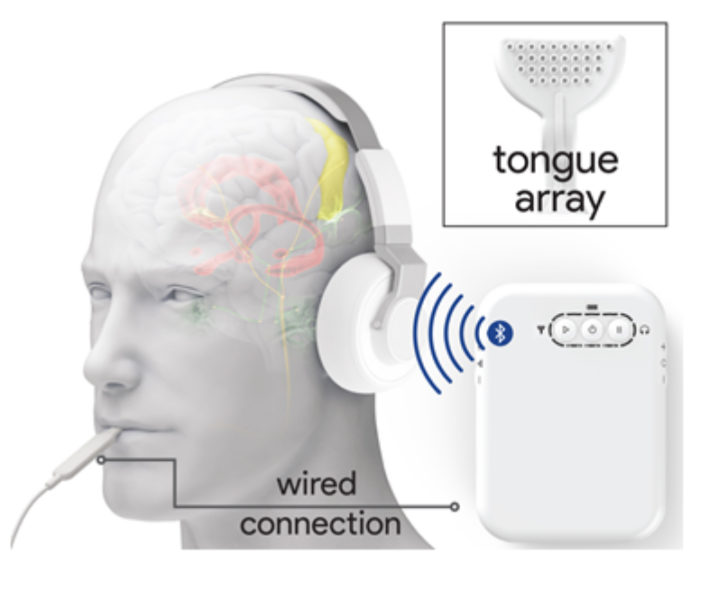Scientists have rewired the brain to suppress tinnitus via a combination of sound and zaps to the tongue. Photo: Neuromod Devices
Tinnitus breakthrough: First effective, viable treatment for ringing in the ears
Scientists have successfully – and non-invasively – rewired the brain in 326 people who were suffering with tinnitus, the irritating and sometimes debilitating phantom ringing in the ears.
Tinnitus affects up to 15 per cent of the population, and there are no approved medical devices or drug treatments.
Millions of people around the world have put up with it for years. And some of them suffer a significant effect on their quality of life.
That may be about to change.
The longest and biggest clinical trial of its type has ended with science showing what a successful treatment might look like.
The multinational team of researchers report that 86 per cent of the trial’s participants – of those who stuck with the treatment for 12 weeks – experienced a substantial reduction in the severity of their symptoms.
Many experienced sustained benefit for a year post-treatment.
How was this achieved?
The treatment uses a technique called ‘bimodal neuromodulation’ – where the brain is changed or modified by two different kinds of stimulation.
In the tinnitus experiment, researchers developed a device that combines “sounds with zaps to the tongue”.

Trial participants wore the device for an hour a day for 12 weeks. Image: B. Conlon et al
According to study co-author Hubert Lim, an associate professor of biomedical engineering and otolaryngology at the University of Minnesota, this treatment “targets a subset of brain cells that are firing abnormally”.
Through studies in both humans and animals, Dr Lim’s team and others previously reported that “electrically stimulating touch-sensitive neurons in the tongue or face can activate neurons in the auditory system”.
Pairing these zaps with sounds “appears to rewire brain circuits associated with tinnitus”.
The trial
The randomised clinical trial was conducted with patients at hospitals in Ireland and Germany.
The participants suffered with different types of tinnitus. (There are four types.)
There were consistent therapeutic outcomes across both clinical sites, with no serious adverse events.
The 326 participants were instructed to use the device for 60 minutes every day for 12 weeks.
The device is now branded for market as Lenire®, developed by Irish company Neuromod Devices.
It consists of wireless headphones that deliver sequences of audio tones layered with wide-band noise to both ears, combined with electrical stimulation pulses delivered to 32 electrodes on the tip of the tongue by a proprietary device trademarked as Tonguetip.
Before using the treatment for the first time, the device was “configured to the patient’s hearing profile and optimised to the patient’s sensitivity level for tongue stimulation”.
The device reduced tinnitus symptoms, and these improvements persisted throughout a 12-month follow-up period.
The researchers note they are currently conducting another large clinical trial to study the effects of changing the stimulation protocol over time.
Out of 326 enrolled participants, 83.7 per cent used the device at or above the minimum compliance level of 36 hours over the 12-week treatment period.
The participants achieved “a statistically and clinically significant reduction in tinnitus symptom severity”.
The researchers concluded that their results “support the safety and potential utility of bimodal neuromodulation for tinnitus”.
The researchers have begun another large study with a view to tweaking the technique.
The accidental discovery
The development of the device came out of an accidental discovery.
Minnesota’s Dr Lim was doing deep brain stimulation on a patient with tinnitus.
The electrode went off course, touching others areas of the brain, and the patient was thrilled to say they couldn’t hear their tinnitus any more.
